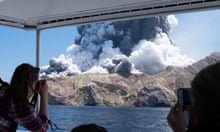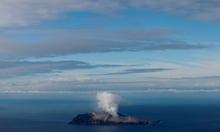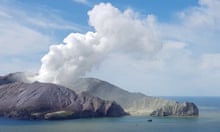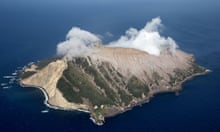Surgeons are working around the clock to help tourists who suffered horrendous burn injuries in the eruption of the New Zealand’s White Island volcano, health experts have said.
New Zealand health authorities have reportedly ordered 1.2 million sq cm of skin from the US in order to treat those injured: 27 of whom had burns to more than 30% of their body, with some having burns to 90-95% of their body. For context, experts say the palm of a hand is about 1.5% of the area of the body.
At present 29 patients are being treated in intensive care and burns units in New Zealand; 22 patients are on airway support.
“We currently have supply but are urgently sourcing additional supplies to meet the supply for dressing and temporary skin grafts,” Counties Manukau district health board’s chief medical officer, Dr Peter Watson, told reporters in a press conference on Wednesday. “These supplies are coming from the United States, and the order has been placed.”
Watson added that injuries sustained by the tourists had been complicated by the mix of gases and chemicals from the disaster.
“This has necessitated more rapid surgical treatment of these burns than is the usual case for thermal-only burns,” he said, adding that the country’s surgical teams have been working “around the clock non-stop” to begin surgical treatment – the start of a process that Watson said for some patients could last several months.
Dr John Kenealy, clinical director of surgery at Middlemore hospital, said: “This number of burns at one time is certainly unprecedented in New Zealand, and it is unprecedented in most countries in the world. These are fortunately rare events.”
However, he said the team were well trained to cope with such injuries. “The patients that we are treating are standard from the point of view that we deal with patients of this severity of burn all of the time,” he said, adding that the team had also been trained for mass casualty events.
A patient with 40-50% burns, he added, would have about eight hours of surgery for the initial procedures.
Jorge Leon-Villapalos, consultant in plastic surgery and burns at Chelsea and Westminster hospital, said many factors needed to be considered when a patient with severe burns was brought in.
“The burn itself may be associated with a number of life-threatening priorities that need to be addressed first of all,” he said.
“There is a possibility that some of these patients may have had damage to the airway because of inhaling toxic gases or very, very hot gases,” he said, adding those problems must be tackled first to prevent the patient dying.
Leon-Villapalos said it was also crucial to provide fluids – as these can be lost when the skin barrier is broken – and to stabilise the patient’s body temperature.
Once the initial priorities were taken care of, he said, the burn itself could be assessed in depth and extent. Deep burns, he said, would require operations to remove the dead skin and replace it with a temporary cover such as a dressing, skin substitute– or donated skin from cadavers which are stored in big tissue banks, typically frozen.
David Barnes, consultant plastic surgeon at Broomfield hospital, Chelmsford, said the latter was most likely what the New Zealand team had ordered. This temporary cover would act as a barrier against infection, fluid loss and physical trauma; donor skin is tested for a wide range of possible diseases before being used. Over time however it would need to be replaced, not least because of rejection by the patient’s body.
“Eventually you graft [the wound] with a patient’s own skin, but that comes once the patient has been stabilised,” Leon-Villapalos added, saying that would take many difficult and time-consuming operations.
All the time, he said, it was important to monitor all the body systems that may have been affected. “A major burn will affect not only the lungs but also the gut, the cardiovascular system – the heart, your blood pressure, your pulse – your ability to fight infections and so on,” he said.
The team would also carefully examine the patient for other injuries. “We do not deal only with the burn itself – it is a trauma situation in which the burn may be the most visually obvious situation, but there are other issues that we need to take into consideration in order not to miss any type of life-threatening situation,” said Leon-Villapalos.
But he stressed that treating patients with severe burns was a multidisciplinary and continuing effort, with experts ranging from anesthetists to nurses, pharmacists to physiotherapists crucial to the work. “It is absolutely a team effort,” he said.
Barnes added that such injuries would take months of care. “It is the biggest insult that you can have in your body, a major burn injury,” he said.









